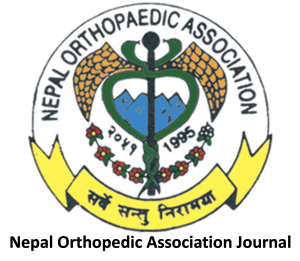Epidemiological Profile of Patients Presenting with Tibia Fractures in a Tertiary Care Center: A Descriptive Cross-Sectional Study
Keywords:
Epidemiological Studies, Motorbike Accidents, Road Traffic Accidents, Tibia FracturesAbstract
Introduction: There is a lack of epidemiological studies on tibia fractures in our part of the world. This study aims to describe the epidemiological profile of the patients presenting with tibia fractures in a tertiary care center.
Method: A descriptive cross-sectional study was conducted at a tertiary care center between September 1, 2017, and October 30, 2019. Hospital records were screened, and patients admitted with the diagnosis of tibia fractures were included in the study. Records with missing information, incomplete diagnoses, and admissions for non-orthopedic problems were excluded. A convenient sampling method was used. Continuous data were reported as mean ± standard deviation and categorical data as frequency (percentage).
Results: A total of 542 patients with 557 tibia fractures were included. The mean age of the patients was 32.61±14.98 years; 422 (77.85%) were males and 120 (22.15%) were females; 103 (19.01%) were less than 20 years, 271 (50%) were 20-40 years, 139 (25.64%) were 41-60 years, and 29 (5.35%) were more than 60 years. The mechanism of injury included Low- energy fall in 44 (8.12%) patients, High-energy fall in 22 (4.06%) patients, road traffic accidents in 440 (81.18%) patients, and others in 36 (6.64%) patients. Among road traffic accidents, pedestrians were 177 (40.23%), Motorbike accidents were 242 (55%), and Car/heavy vehicle accidents were 21 (4.77%).
Conclusion: Most patients with tibia fractures were 20-40 years old. RTA, especially motorbike accidents, was the most common mechanism of injury. Most findings in this study were comparable to those reported by published epidemiological studies.
Downloads
Downloads
Published
How to Cite
Issue
Section
License
Copyright (c) 2024 Nitesh Raj Pandey, Niresh Shrestha, Rajendra Aryal, Subhash Regmi, Satish Prasad Barnwal, Bibek Banskota

This work is licensed under a Creative Commons Attribution-NonCommercial-NoDerivatives 4.0 International License.
CC BY-NC-ND This license allows reusers to copy and distribute the material in any medium or format in unadapted form only, for noncommercial purposes only, and only so long as attribution is given to the creator.

